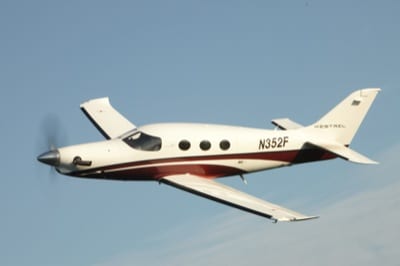Alan Klapmeier is back. The co-founder of Cirrus Aircraft is now at the helm of Kestrel Aircraft, a new company that plans to complete certification of the former Farnborough F1, a six-place composite turboprop that’s been under development in the United Kingdom since 2002.
Klapmeier, known in the GA industry as a visionary, left Cirrus in 2009 after he and his brother, Dale, gave up a controlling interest in the company to Arcapita, an Atlanta-based equity firm. The outspoken Klapmeier clashed with the new board, which forced him out of the company he built after he tried to take over the company’s jet project.
Since then, he’s been searching for a new project and even considered starting from scratch, he said. But the Kestrel has all the elements he was looking for, plus a little more. “It gives me a warm, fuzzy feeling,” he said.
Klapmeier was first introduced to the aircraft while he was at Cirrus, when the UK team developing the plane contacted the company about working together on component manufacturing.

The relationship became official this summer, when Kestrel Aircraft was created — in time to show off its prototype at Oshkosh — and struck a deal to base its operations at Brunswick Landing in Maine, at a soon-to-be decommissioned Naval Air Station. The company will lease Hanger #6, a 170,000-square-foot aviation maintenance facility that was built in 2004. The Kestrel venture will involve an investment of more than $100 million and is expected to create more than 300 jobs once the company is in full production.
When that will be is still unknown. While at Oshkosh, Klapmeier said it was too early to reveal any plans, including a price for the Kestrel.
“The next step is to put the team back together and look at what we have,” he said. “Once we understand what we need, then we can be more open about our plans and getting on with the certification process.
“The FAA has only one question: Prove it,” he continued. “The trickier part is how to satisfy customers after the fact.”
In its initial outreach to prospective customers, Kestrel uses the tagline “Disruptive innovation.”
“The Kestrel is already disruptive to preconceptions and exactly what you expect from the man who brought you Cirrus,” a company brochure states.
What is all boils down to, according to Klapmeier, is customer value. “We tried to make sure we are using innovation, not technology,” he said, “We’re not inventing new technology, but using technology differently.”
The goal is to recreate in prospective owners that “warm fuzzy feeling” that Klapmeier feels when he looks at the aircraft.
Of course, the foundation of that feeling is the aircraft itself, which will boast cutting edge flat panel displays and an ergonomically designed cockpit that the company hopes will offer “a satisfying experience where the pilot and aircraft become one.”
The composite aircraft, which will have a range of flexible cabin configurations, is designed to “bridge the traditional gap between turboprops and substantially more expensive business jets,” according to Kestrel officials.
Now powered by a Pratt & Whitney Canada PT6A engine, one of the first tasks for the new Kestrel team will be to evaluate whether to keep that engine or replace it, possibly with one that is now in development by GE Aviation. Expect other design changes, including a reshaping of the scimitar shaped wing leading edge, which increases production and manufacturing costs.
Klapmeier concedes that “there are a lot of cool things going on in aviation.” So how will the Kestrel stand out from the crowd?
“The first part is performance,” he said. “It carries a big payload, can go longer distances and land on short runways.”
But it’s the “softer criteria” — such as making the plane user friendly — that is every bit as important, he said. “You can’t put numbers on that,” he said. “You can’t put a metric on comfort.”
For more information: Kestrel.aero

